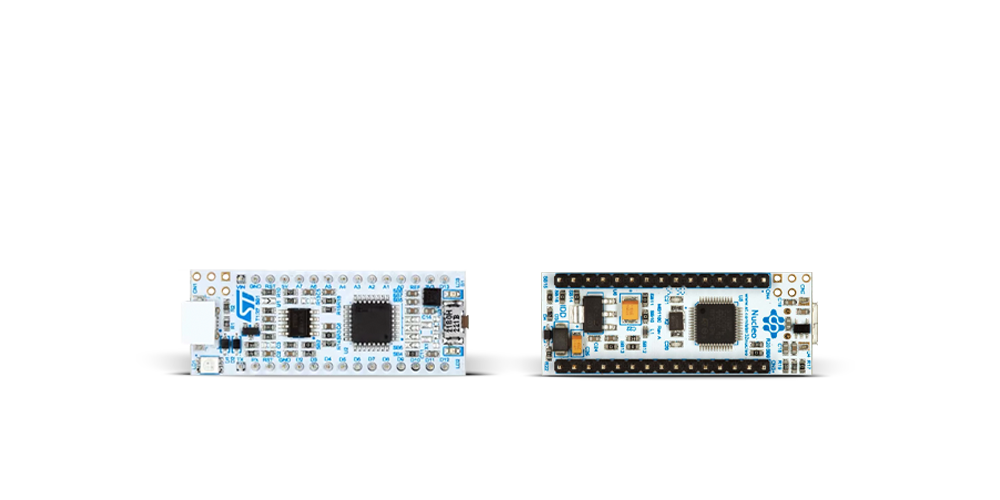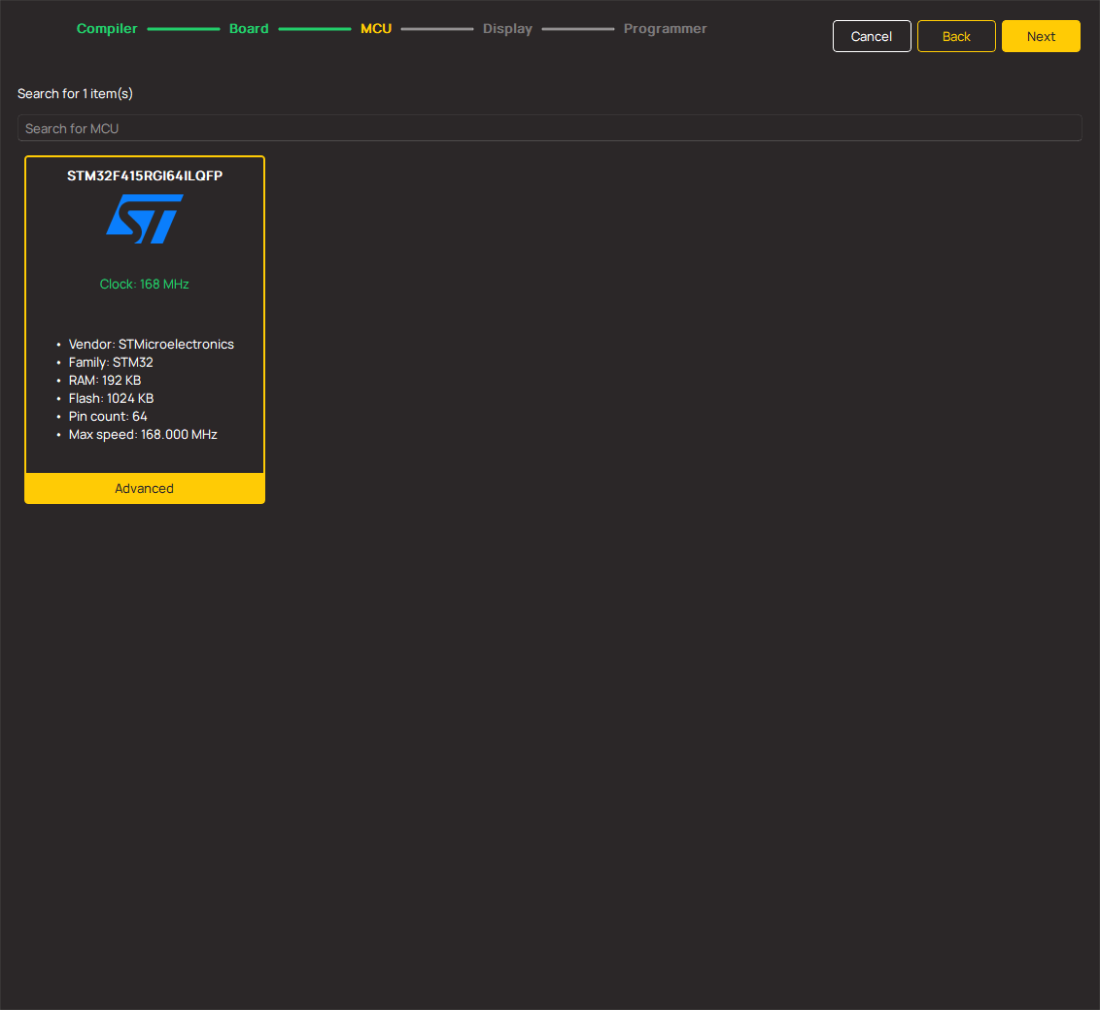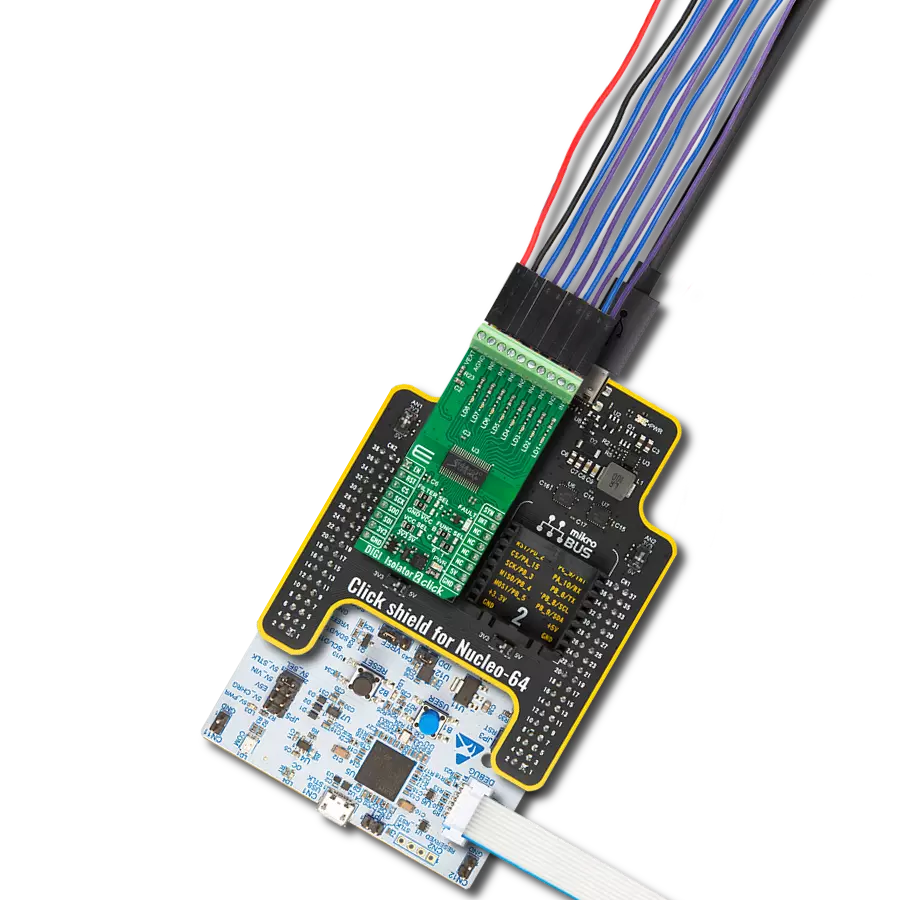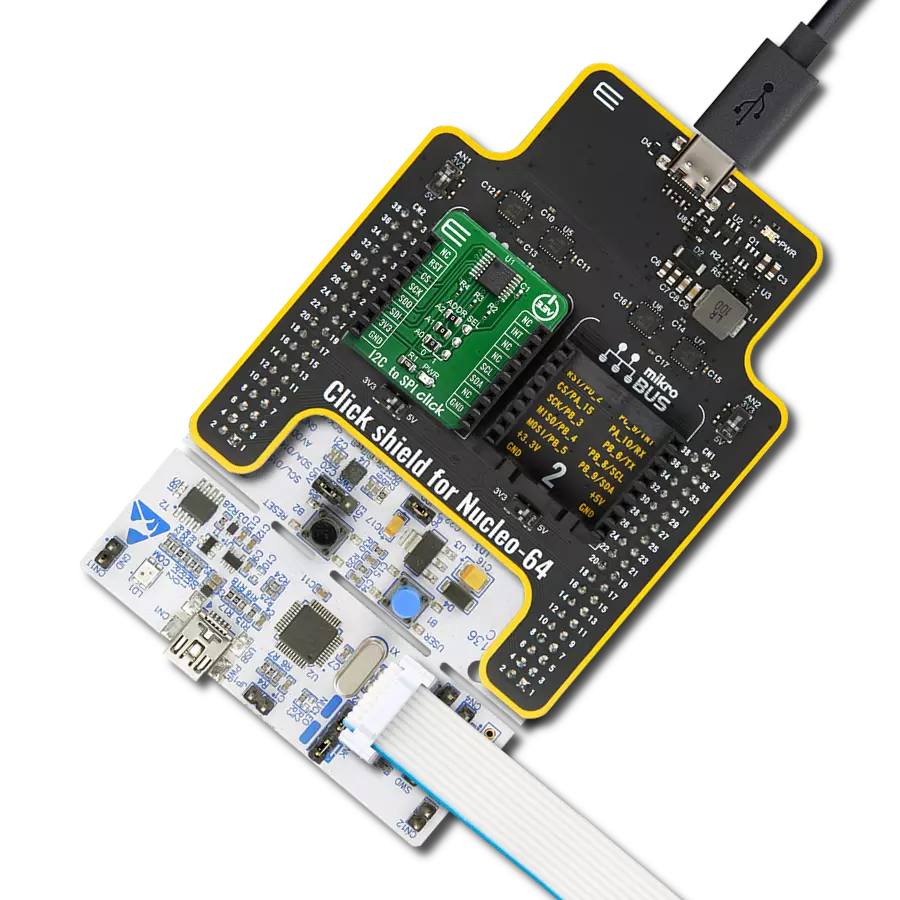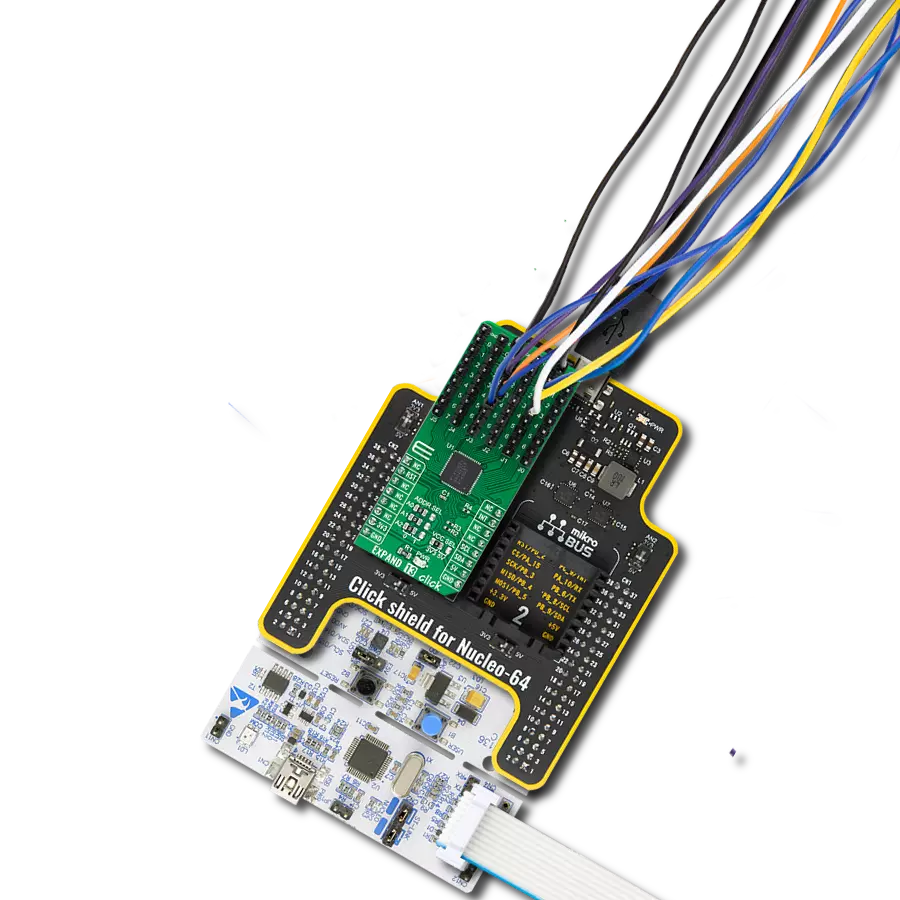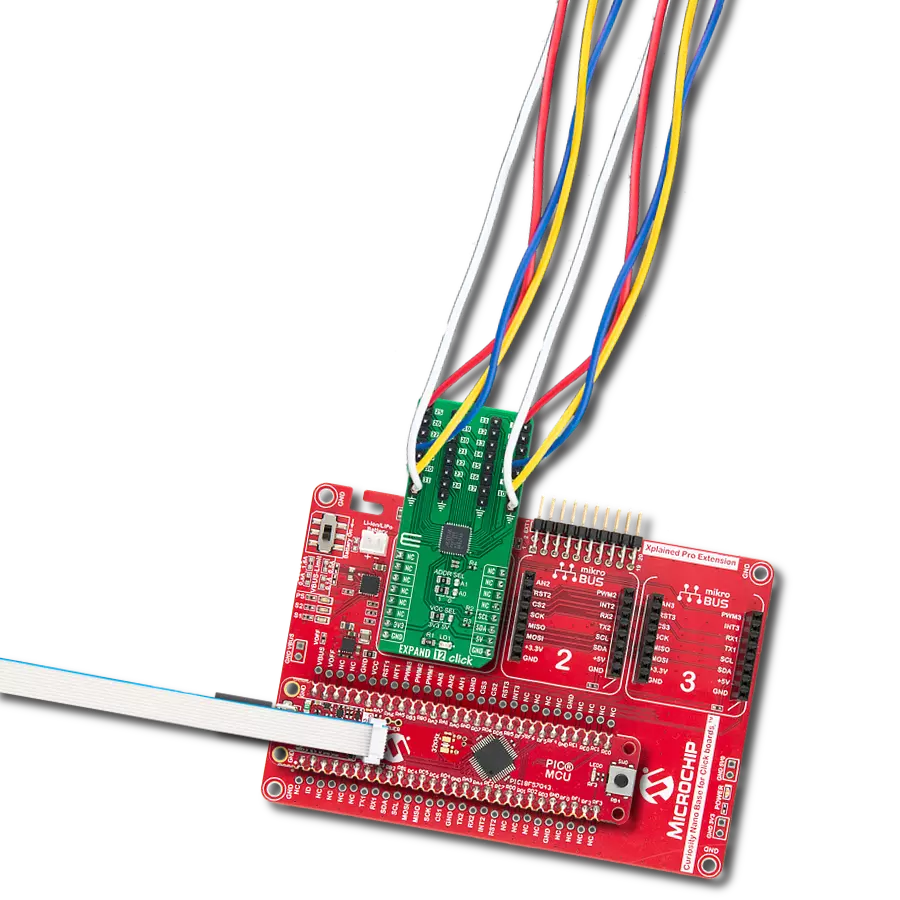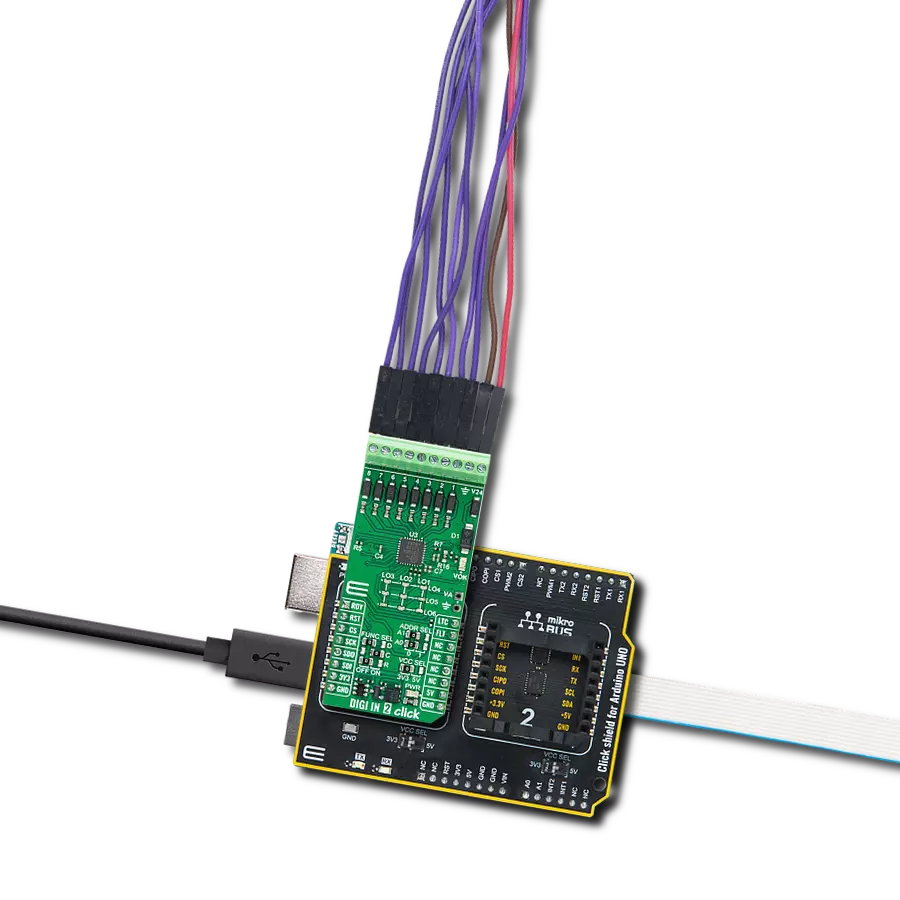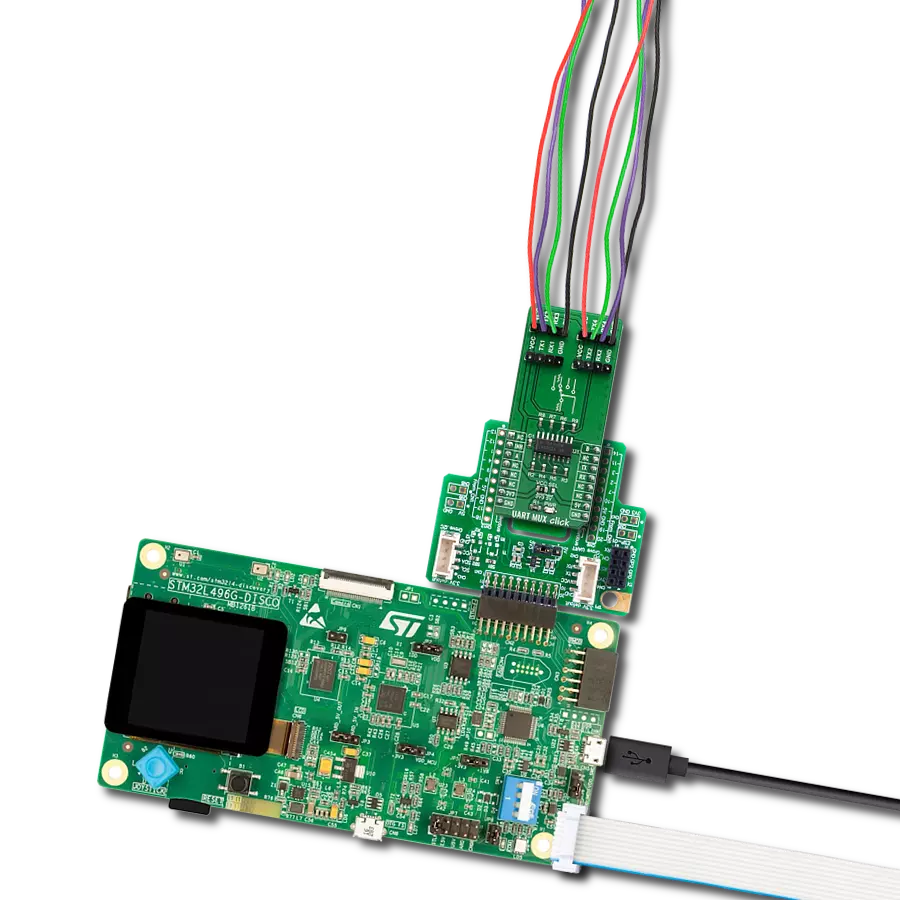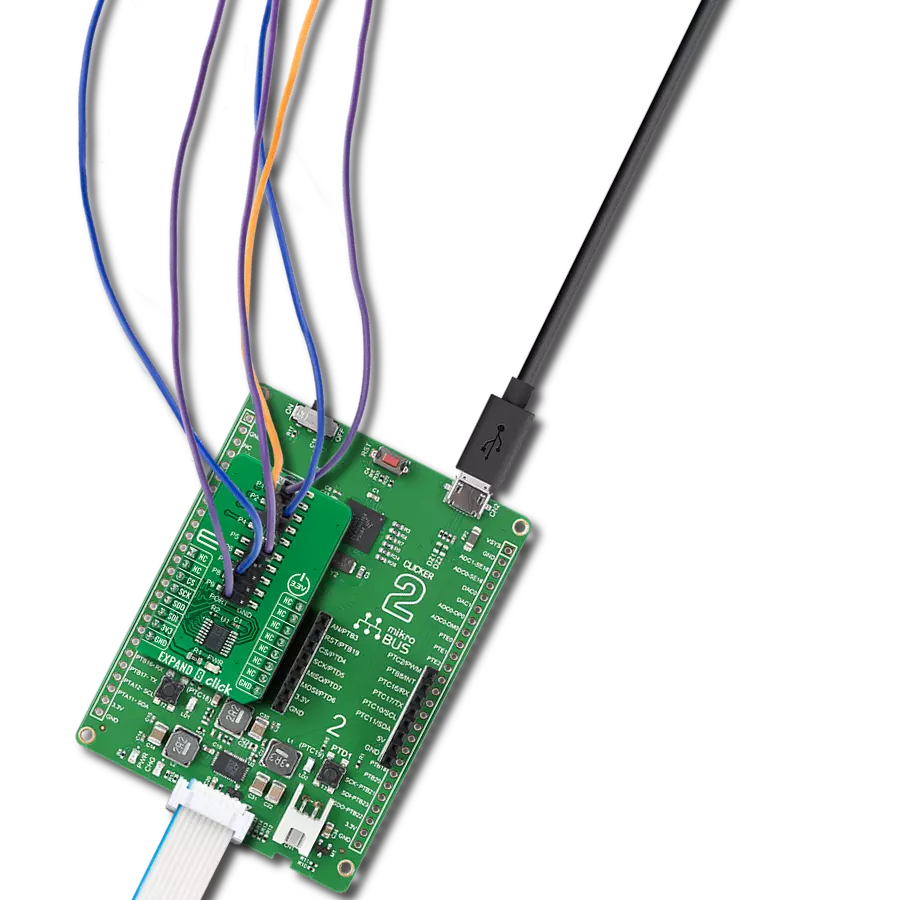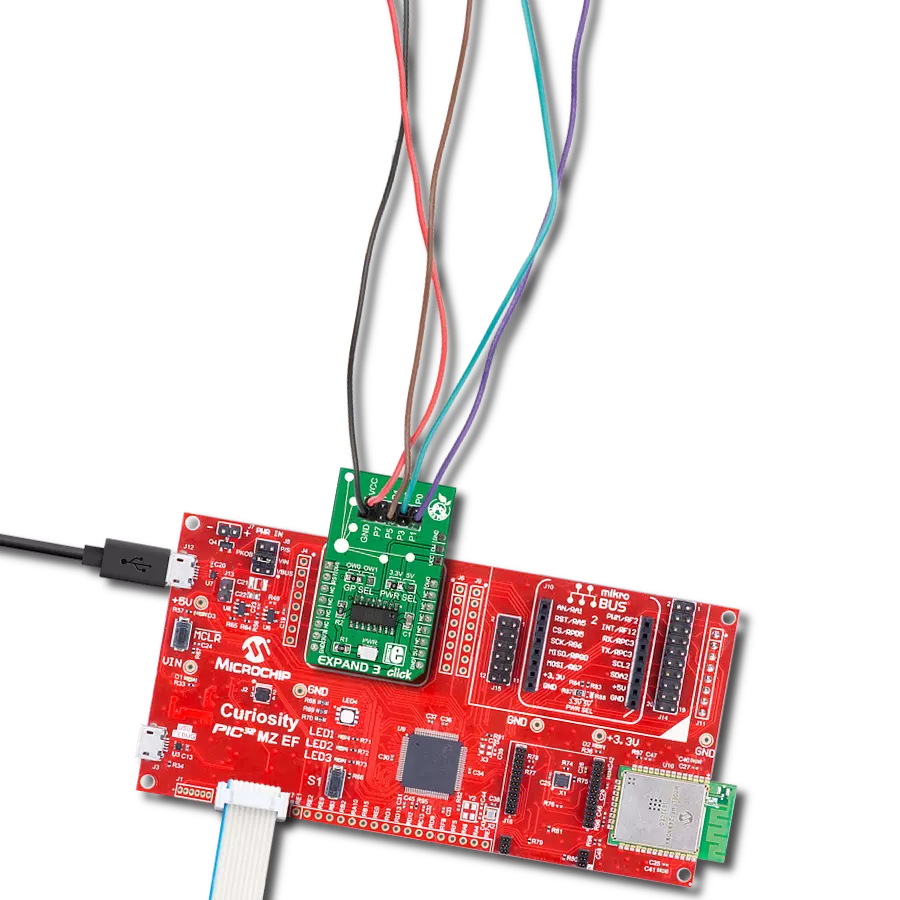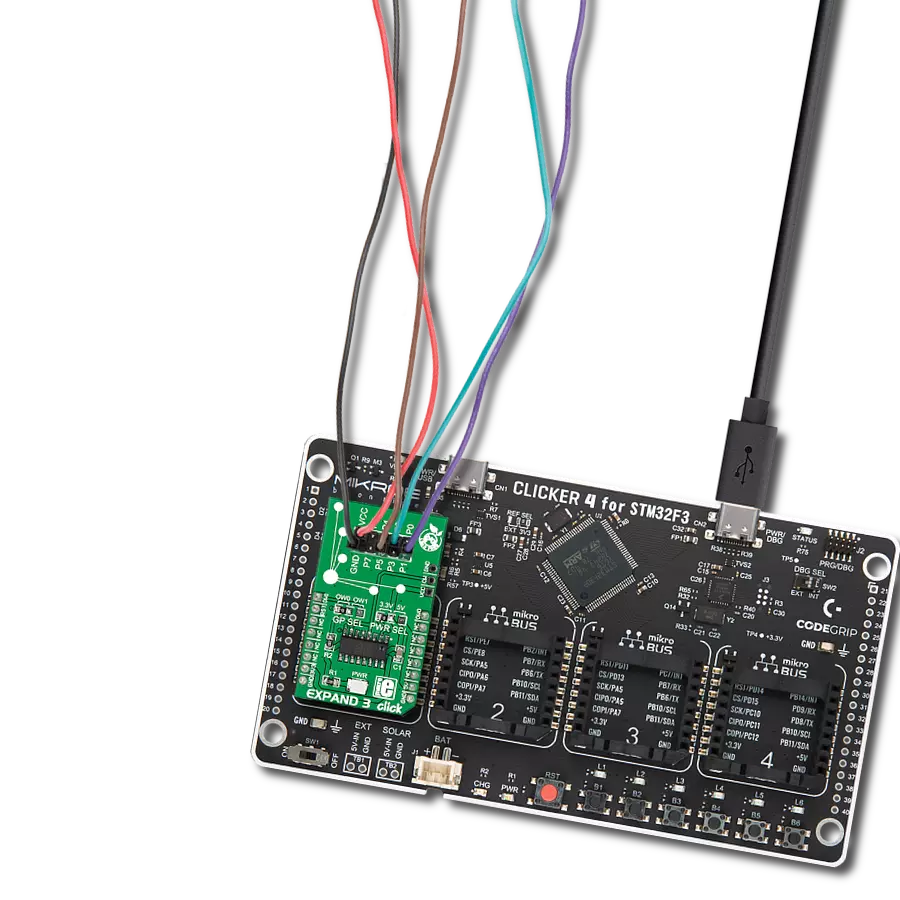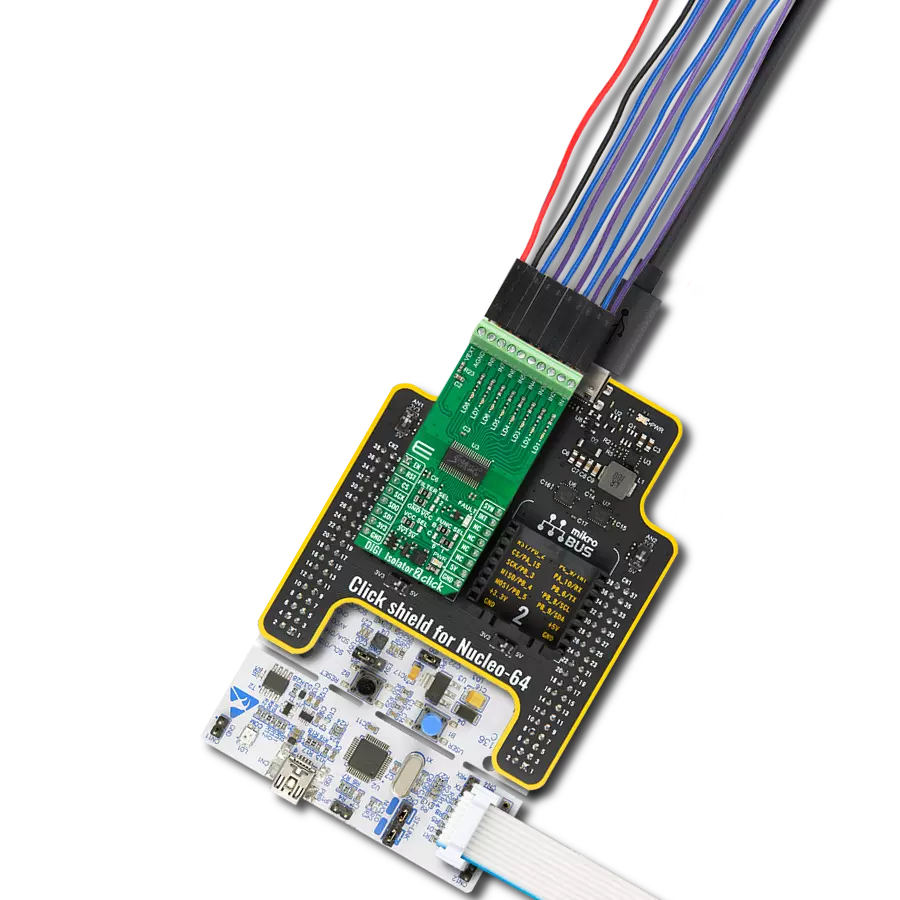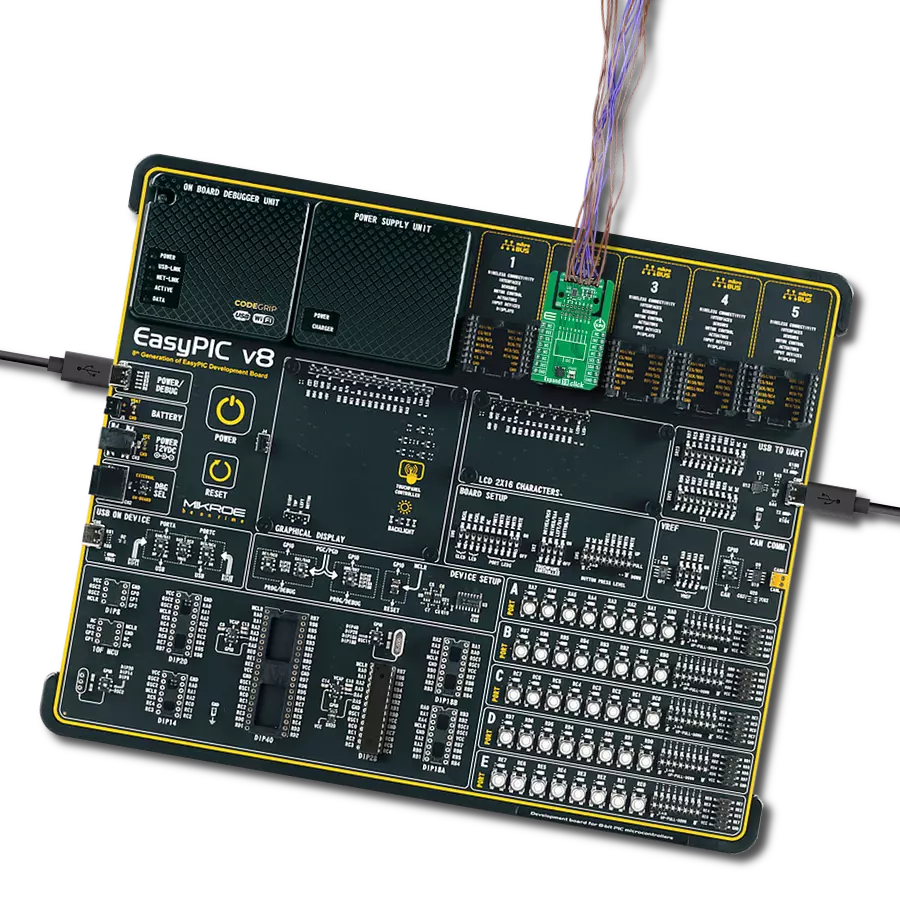Boost your microcontroller's capabilities with a versatile and trustworthy port expander
A
A
Hardware Overview
How does it work?
Expand 14 Click is based on the CAT9555, a general-purpose I/O expander from ON Semiconductor. It contains two 8-bit configuration ports (input or output), input, output, and polarity inversion registers, alongside an I2C-compatible serial interface, where any of the sixteen I/Os can be configured as an input or output by writing to the configuration register. This port expander represents a simple solution when additional I/Os are needed while keeping interconnections to a minimum; particularly great for sensors, power switches, LEDs, pushbuttons, and fans. Each I/O port is 5V input tolerant, with a high current
I/O drive sink of up to 25mA and an I/O source of up to 10mA, maximum. Additionally, each I/O port is compatible with logic thresholds of 2.5V, 3.3V, and 5V. This Click board™ communicates with MCU using the standard I2C 2-Wire interface with a maximum clock frequency of 400kHz. The CAT9555 has a 7-bit slave address with the first four MSBs fixed to 0100. The address pins A0, A1, and A2 are programmed by the user and determine the value of the last three LSBs of the slave address, which can be selected by positioning onboard SMD jumpers labeled as ADDR SEL to an appropriate position marked as 0 or 1.
Besides, it also features an active-low interrupt feature, routed to the INT pin of the mikroBUS™ socket, indicating to the host controller that an input state has been changed. This Click board™ can operate with either 3.3V or 5V logic voltage levels selected via the VCC SEL jumper. This way, both 3.3V and 5V capable MCUs can use the communication lines properly. However, the Click board™ comes equipped with a library containing easy-to-use functions and an example code that can be used, as a reference, for further development.



Features overview
Development board
Nucleo 32 with STM32F031K6 MCU board provides an affordable and flexible platform for experimenting with STM32 microcontrollers in 32-pin packages. Featuring Arduino™ Nano connectivity, it allows easy expansion with specialized shields, while being mbed-enabled for seamless integration with online resources. The
board includes an on-board ST-LINK/V2-1 debugger/programmer, supporting USB reenumeration with three interfaces: Virtual Com port, mass storage, and debug port. It offers a flexible power supply through either USB VBUS or an external source. Additionally, it includes three LEDs (LD1 for USB communication, LD2 for power,
and LD3 as a user LED) and a reset push button. The STM32 Nucleo-32 board is supported by various Integrated Development Environments (IDEs) such as IAR™, Keil®, and GCC-based IDEs like AC6 SW4STM32, making it a versatile tool for developers.
Microcontroller Overview
MCU Card / MCU
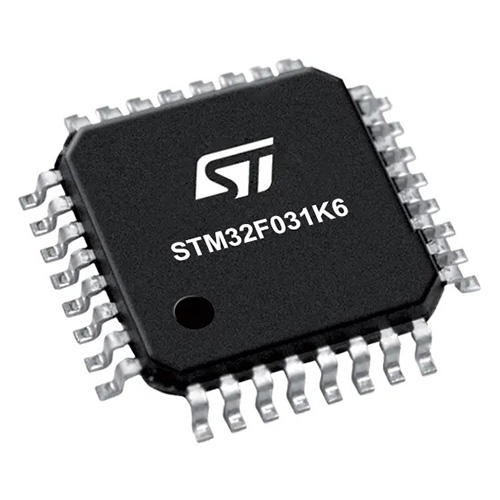
Architecture
ARM Cortex-M0
MCU Memory (KB)
32
Silicon Vendor
STMicroelectronics
Pin count
32
RAM (Bytes)
4096
You complete me!
Accessories
Click Shield for Nucleo-32 is the perfect way to expand your development board's functionalities with STM32 Nucleo-32 pinout. The Click Shield for Nucleo-32 provides two mikroBUS™ sockets to add any functionality from our ever-growing range of Click boards™. We are fully stocked with everything, from sensors and WiFi transceivers to motor control and audio amplifiers. The Click Shield for Nucleo-32 is compatible with the STM32 Nucleo-32 board, providing an affordable and flexible way for users to try out new ideas and quickly create prototypes with any STM32 microcontrollers, choosing from the various combinations of performance, power consumption, and features. The STM32 Nucleo-32 boards do not require any separate probe as they integrate the ST-LINK/V2-1 debugger/programmer and come with the STM32 comprehensive software HAL library and various packaged software examples. This development platform provides users with an effortless and common way to combine the STM32 Nucleo-32 footprint compatible board with their favorite Click boards™ in their upcoming projects.
Used MCU Pins
mikroBUS™ mapper
Take a closer look
Click board™ Schematic

Step by step
Project assembly
Software Support
Library Description
This library contains API for Expand 14 Click driver.
Key functions:
expand14_set_pin_directionThis function sets the direction of the selected pins.expand14_set_all_pins_valueThis function sets the value of all output pins.expand14_read_port_valueThis function reads the value of the selected port input pins.
Open Source
Code example
The complete application code and a ready-to-use project are available through the NECTO Studio Package Manager for direct installation in the NECTO Studio. The application code can also be found on the MIKROE GitHub account.
/*!
* @file main.c
* @brief Expand14 Click example
*
* # Description
* This example demonstrates the use of Expand 14 Click board by setting and reading
* the ports state.
*
* The demo application is composed of two sections :
*
* ## Application Init
* Initializes the driver and performs the Click default configuration which sets
* the port 0 as output and the port 1 as input.
*
* ## Application Task
* Sets the pins of the port 0 and then reads the status of both ports and
* displays the results on the USB UART approximately once per second.
*
* @author Stefan Filipovic
*
*/
#include "board.h"
#include "log.h"
#include "expand14.h"
static expand14_t expand14;
static log_t logger;
void application_init ( void )
{
log_cfg_t log_cfg; /**< Logger config object. */
expand14_cfg_t expand14_cfg; /**< Click config object. */
/**
* Logger initialization.
* Default baud rate: 115200
* Default log level: LOG_LEVEL_DEBUG
* @note If USB_UART_RX and USB_UART_TX
* are defined as HAL_PIN_NC, you will
* need to define them manually for log to work.
* See @b LOG_MAP_USB_UART macro definition for detailed explanation.
*/
LOG_MAP_USB_UART( log_cfg );
log_init( &logger, &log_cfg );
log_info( &logger, " Application Init " );
// Click initialization.
expand14_cfg_setup( &expand14_cfg );
EXPAND14_MAP_MIKROBUS( expand14_cfg, MIKROBUS_1 );
if ( I2C_MASTER_ERROR == expand14_init( &expand14, &expand14_cfg ) )
{
log_error( &logger, " Communication init." );
for ( ; ; );
}
if ( EXPAND14_ERROR == expand14_default_cfg ( &expand14 ) )
{
log_error( &logger, " Default configuration." );
for ( ; ; );
}
log_info( &logger, " Application Task " );
}
void application_task ( void )
{
uint8_t port_value = 0;
for ( uint16_t pin_num = EXPAND14_PIN_0_MASK; pin_num <= EXPAND14_PIN_7_MASK; pin_num <<= 1 )
{
expand14_set_all_pins_value( &expand14, pin_num );
expand14_read_port_value( &expand14, EXPAND14_PORT_0, &port_value );
log_printf( &logger, " Status port 0 (output): 0x%.2X\r\n", ( uint16_t ) port_value );
expand14_read_port_value( &expand14, EXPAND14_PORT_1, &port_value );
log_printf( &logger, " Status port 1 (input) : 0x%.2X\r\n\n", ( uint16_t ) port_value );
Delay_ms ( 1000 );
}
}
int main ( void )
{
/* Do not remove this line or clock might not be set correctly. */
#ifdef PREINIT_SUPPORTED
preinit();
#endif
application_init( );
for ( ; ; )
{
application_task( );
}
return 0;
}
// ------------------------------------------------------------------------ END
Additional Support
Resources
Category:Port expander

